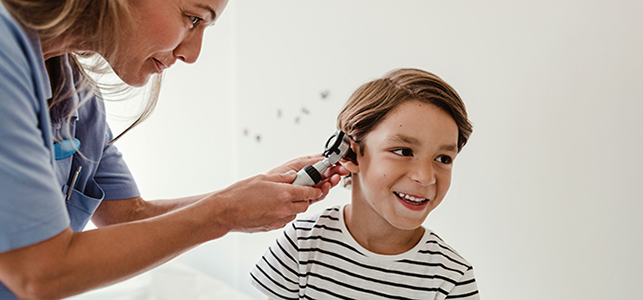
May is Better Hearing and Speech Month
Beep, beep, beep. That’s the alarm – time to get up! Was that a rumble of thunder? We better head inside. Listen up! The teacher is giving instructions for the big test.
We’re constantly relying on our hearing for important daily activities. With 38 million Americans experiencing varying degrees of hearing loss, imagine how much they may be missing out on if it goes undetected. Untreated hearing loss can impact relationships, cognitive abilities and general quality of life.
Amy Stevenson, M.S., CCC-A, senior audiologist, answers some key questions about hearing loss
How common is hearing loss in kids?
Four in every 1,000 kids are born with hearing loss in one or both ears. By age 12, it’s thought that 20% of children have some degree of hearing loss. The chance of hearing loss increases as we age. About a third of older adults are impacted.
When and how is hearing loss in babies usually detected?
Newborns have their hearing screened within one month of birth. This is done using earphones and electrodes to assess the hearing nerve and the brain’s response to sound. If hearing loss is detected, further diagnostic testing is recommended by 3 months. Next steps are determined based on the findings of those tests.
What about hearing loss that may begin after the newborn period? Are there signs a child may be experiencing hearing loss?
The following are some signs your child may be struggling with hearing loss that perhaps wasn’t present or detected in their early screenings:
- Delayed or abnormal speech
- Not responding to voices or loud sounds
- Not paying attention
- Learning issues
Hearing is also checked at well visits with the pediatrician throughout childhood. If you have concerns between those visits, check in with the doctor.
What causes hearing loss?
Hearing loss can stem from a variety of causes, including:
- Age
- Certain genetic/inherited conditions
- Cytomegalovirus (CMV) and other congenital (present at birth) infections
- Disease
- Exposure to loud noise
- Prematurity
What kind of treatment is available for hearing loss in kids?
Once the type and degree of hearing loss have been determined through testing, an evaluation with an ENT specialist will help identify if hearing aids are medically appropriate. If so, that’s typically the first approach used to improve hearing. Hearing aids go in or behind the ear and amplify sounds to improve hearing and speech comprehension. Sounds come in through a microphone in the hearing aid and are converted to digital signals. An amplifier within the hearing aid increases the strength of those signals, and the ear receives the amplified sound through a tiny speaker.
For more severe hearing losses, cochlear implants may be a better option. Cochlear implants are designed to bypass damaged parts of the inner ear. A microphone is attached to the outside of the ear to pick up sounds and send them to a processor that turns the sounds into digital information. A receiver, or stimulator, which is surgically placed under the scalp receives this information and sends electrical impulses to stimulate the auditory nerve. The brain can then recognize these sounds. Sounds heard through cochlear implants are similar to those heard by someone with normal hearing. Auditory-verbal therapy is a sub-specialty of speech therapy used to help these children acquire speech after implantation of the cochlear implant.
What are some ways to protect hearing?
Not all types of hearing loss can be prevented, but noise exposure can be. It’s generally a good idea to stay away from loud sounds. When you can’t, be sure to use hearing protection.
